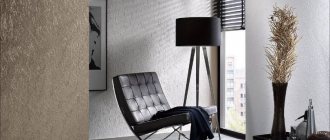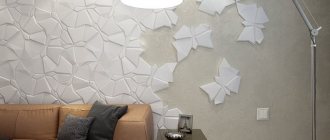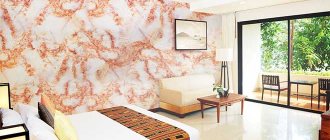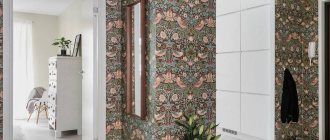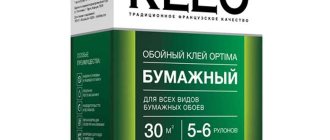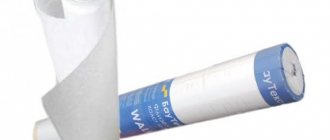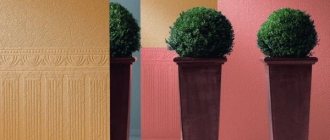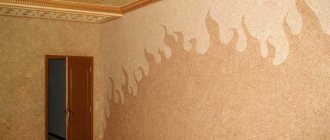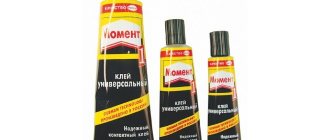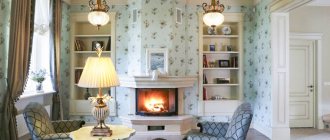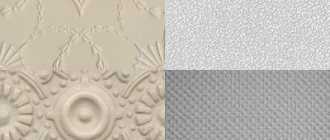SHARE ON SOCIAL NETWORKS
FacebookTwitterOkGoogle+PinterestVk
This article discusses paper, non-woven and fiberglass wallpaper for painting: the pros and cons of each type of finishing material, their features and characteristics, as well as prices for products from popular brands. In the text you can find tips on choosing a dye to create a finishing layer on wallpaper, as well as average prices for services performed by professional painters.
Paintable wallpaper in the living room
Paintable wallpaper - what is it, why do we need it?
Rolled finishing, on which you can apply a layer of paint, is a good opportunity to change the design of rooms and update walls without extra costs. Wallpaper is the most acceptable option for decorating premises for various purposes. They are used in residential buildings, apartments, offices, offices, and reception areas.
Depending on the base, paint coatings are applied to the wallpaper up to 10 times. Wallpaper is produced on a non-woven, paper base, made from fiberglass, and vinyl is used to create texture.
In children's rooms and living rooms, it is better to choose finishing made from environmentally friendly fiberglass; for the kitchen and hallway, anti-vandal options are suitable, which are not afraid of cleaning with detergents.
Rolled finishing, on which you can apply a layer of paint, is a good opportunity to change the design of rooms and update walls without extra costs.
Features and Specifications
Textured and smooth roll finishes, when repainted in a different color, are usually made white or light monochrome. Only 5% of paintable wallpapers on the market today are colored. Textured finishing materials look excellent; a structured pattern helps create a unique design. The room will look stylish and modern.
By the way, when using textured paint and special tools on smooth plastered walls, specialists create a texture layer.
Textured and smooth roll finishes, when repainted in a different color, are usually made white or light monochrome.
When choosing wallpaper finishes, several criteria are taken into account:
- Cost, models of different price categories are presented;
- Strength, the durability of the material used depends on this;
- The width of the roll, wide, is convenient for flat areas where there are no multi-level transitions, pipelines, cable channels; when using them, few joints are formed (the most common width is one meter);
- Appearance, manufacturers allow you to realize the most daring ideas.
Using reusable coverings is an economical interior design idea. Why buy new wallpaper, if it’s easier to paint the old ones, you can radically change the color.
Fiberglass is the most durable and can withstand more than 10 stains. Paintable paper-based wallpaper is at the very bottom of the durability rating. Non-woven fabric and vinyl occupy intermediate positions.
Using reusable coverings is an economical interior design idea.
Wallpapering
Non-woven
First, close all the windows and doors to the room. This is necessary to avoid drafts. To complete the work, the following materials and equipment are required:
- wallpaper;
- PVA glue;
- pencil;
- primer composition;
- roulette;
- knife;
- wallpaper smoother;
- brush for primer and glue;
- ruler.
There is no need to level the walls before painting, as the paint will mask all minor defects. The surface is carefully primed with 2-3 layers of sealant. This will improve the adhesive properties of the coating. The glue is also diluted, but not too much - it should be thick.
Painting wallpaper without a pattern will not be difficult, but if it is available, you will need a fitting card (it is located on the packaging). The map also contains information about the interval after which the pattern is repeated. When cutting wallpaper, move the new roll to the required distance. The figure below shows typical material markings.
Work order:
- We measure the height of the walls. We cut the rolls into fragments using a ruler, pencil and tape measure.
- We begin gluing the sheets from a window or a distant corner of the room. Using a tape measure, measure the distance from the corner corresponding to the width of the roll. Make a mark with a pencil.
- We apply glue to the place where the first sheet will be strengthened.
- We take a sheet of wallpaper and align it along the line marked on the wall along the width of the sheet. Please note: it is not the wallpaper that needs to be treated with glue, but the place where it will be pasted.
- We level the sheet with our hands and a smoothing iron. We carry out the process with leisurely movements from left to right.
- If there are any obstacles on the wall (pipe, sockets, etc.), use a knife to make appropriate cuts on the sheet.
- Next, we repeat the previously performed steps with new sheets of wallpaper. However, now we smooth them out from the joint - towards the left.
- All that remains is to paint the canvas.
Glass wallpaper
Rolls of fiberglass are most often made in the form of photo wallpaper. The components of the product (dolomite, limestone, soda and quartz) are combined with a paper base, resulting in a finishing material with high consumer characteristics.
We apply fiberglass wallpaper in several stages:
- We remove the old coating.
- Using high-quality glue, we process a section of the wall and apply wallpaper to it.
- The fabric must be glued in such a way as to avoid getting fragments of fiberglass material on the skin. Glass fiber particles irritate the skin.
Paper
Paper-based wallpaper is usually equipped with a pattern. Although such canvases are inexpensive, gluing them is associated with difficulties. Inept actions can lead to the appearance of folds or bubbles on the canvas. At the same time, properly glued wallpaper is durable, as it has a two-layer structure.
An important feature when gluing paper wallpaper is the need to treat the sheet itself with glue, and not just the wall. We carefully apply the coated sheet to the wall and slowly - using a roller - smooth it out with even movements. If you work with a spatula rather than a roller, the likelihood of bubbles appearing can be significantly reduced. However, you need to be careful not to tear the sheet.
When gluing smooth paper wallpaper, you will need to prepare the walls, otherwise all the defects on them will be noticeable. Preparatory activities include the following:
- removing old paint or coating;
- plastering the surface to level it;
- padding.
If there are significant cracks on the surface, we seal them with putty. We glue paper-backed wallpaper end-to-end - without adjustment. They usually dry within 24 hours.
What kinds of wallpaper can be painted, the pros and cons
In interiors, designers use textured and smooth finishes. Each type of wallpaper for painting has pros and cons, it’s worth saying more about them.
Non-woven wallpaper for painting
A non-woven thin base is made from cellulose or synthetic fibers; vinyl is used for bulk.
Advantages of non-woven fabric:
- Low specific gravity, light rolls;
- Minimize the disadvantages of concrete, other building materials, and the plaster layer;
- Easy to stick, excellent adhesion;
- Hides shrinkage cracks in new buildings.
Flaws:
- Vinyl applied to create a textured finish is fragile;
- Shallow relief becomes invisible after several layers of paint;
- Some types stretch too much after applying the adhesive.
A non-woven thin base is made from cellulose or synthetic fibers; vinyl is used for bulk.
Fiberglass wallpaper for painting
The fabric is woven in various types and thicknesses. Fibers are glass threads, they are drawn from a mass welded from the charge. It includes:
- Fine-grained quartz sand;
- Dolomite flour, which adds density;
- Chalk or lime used as filler;
- Soda Ash.
Pros of fiberglass:
- Resistance to external factors;
- Fire resistance, non-flammability;
- There are no problems when gluing;
- It washes well and does not break when using a brush.
Such wallpaper can often be seen in crowded places. Alas, the material also has disadvantages:
- No distinct texture;
- High cost (the most expensive of all paintable wallpapers);
- Difficult dismantling - during repairs, it is problematic to remove fiberglass from the wall;
- Apply only to a perfectly prepared surface that does not have any unevenness;
- Paintwork is difficult to apply evenly; practice is required.
Fibers are glass threads, they are drawn from a mass welded from the charge.
Paper models
These are traditional two-layer products made using modern technologies using fiber paper and wood chips. The outer layer is embossed to add volume.
Advantages of paper:
- Low repair costs;
- The ability to pass air - the walls “breathe”;
- Due to embossing, irregularities are hidden;
- Suitable for water-based painting.
For all the pros, there are still some cons:
- Not durable, may tear when sticking;
- They become deformed in new buildings and immediately respond to shrinkage;
- They are short-lived and have to be updated frequently; manufacturers guarantee a 5-year service life.
These are traditional two-layer products made using modern technologies using fiber paper and wood chips.
Paintable vinyl wallpaper on non-woven backing
Feature of finishing using polyvinyl chloride polymer, which hardens under a layer of paint without cracking. Vinyl, which is fragile in structure, is strengthened when the paint fills the pores on the surface.
Advantages of the material:
- The relief does not crumble from an accidental impact load thanks to the protective layer;
- Cleans well;
- The non-woven base holds well on the walls;
- Wallpaper retains its strength even when slightly wet due to leaks.
Flaws:
- The relief smoothes out over time;
- Beginners sometimes experience unpainting due to the wrong choice of tool.
The relief does not crumble from accidental impact due to the protective layer.
Smooth wallpaper without a pattern for painting
When choosing, the strength and durability of the material are taken into account. For stickers, roll products are used, creating smooth surfaces for certain style decisions that require a shift in emphasis from the walls to other interior items. Reliefs and drawings are unacceptable in these cases.
When choosing, the strength and durability of the material are taken into account.
Structural wallpaper for painting
Manufacturers delight lovers of classic original designs with wallpapers with all kinds of textured patterns. What they are is described below. Working with texture models is no different, the only drawback is that when using thick paint, the texture quickly levels out and loses its former attractiveness.
The more interesting the structure of the sheet coverings, the more unusual it will look when painted. When choosing wallpaper, you should take into account the depth of the relief and the presence of sharp edges that create a 3-D effect.
Manufacturers delight lovers of classic original designs with wallpapers with all kinds of textured patterns.
Anti-vandal wallpaper for painting
In places where there is high humidity, an increased risk of accidental mechanical impact, and a lot of dirt, it is recommended to use wallpaper with special strength characteristics. If there are children or pets in the house, anti-vandal models from the famous Erfurt brand will turn out to be the most practical. Sheets with a complex polymer coating are considered vandal-proof; plasticizers are added to polyvinyl chloride, forming a hard but plastic structure. Wallpaper is wear-resistant and not prone to scratches. Minor defects in the vinyl will be hidden by another coat of paint.
Polymer coatings are environmentally friendly, do not emit harmful substances, have an interesting texture, and there are models with fancy designs and reliefs.
In places where there is high humidity, an increased risk of accidental mechanical impact, and a lot of dirt, it is recommended to use wallpaper with special strength characteristics.
DIY wallpaper painting
The initial stage of decorating a room is pasting the walls. The gluing process begins from the corner from the window towards the exit. Thanks to this approach, joints or overlaps become less visible. The technology for applying glue depends on the type of wallpaper selected. For some, applying glue to the wall is enough, while others require applying adhesive to the strip and the wall.
See also: Finishing putty
After the process has been completely completed and the walls have dried, you can begin painting. If you don’t know how to paint wallpaper correctly, you can take the advice of experienced specialists. Provided that all recommendations are followed, the final result will bring the desired effect.
Tools and materials needed for painting
Before you get started, you should make sure you have everything you need:
- paint is applied with a fur roller;
- if you have chosen wallpaper with a smooth surface, and you plan to have a pattern in your design project, then you need a brush to create patterns from paint;
- plastic bath;
- container for performing the paint coloring procedure;
- colors;
- acrylic-based varnish, if you need to create an additional protective layer.
Preparing the Paint
Initially, you should decide on the type of paint that can be applied to the surface of the selected wallpaper. For non-woven bases, the use of oil-based paints is strictly prohibited; it is better to use water-based paints. While for glass wallpaper it is advisable to peel off alkyd or latex paints.
If we talk about choosing a color, then in stores you can find ready-made options, ready for application. Despite their wide range, most people want to use unique colors that can be created by coloring standard white paint with tints. The color is added to the white paint according to the already developed tinting table. Add the required amount of color to a separate container with cast paint and mix thoroughly.
Carefully apply the resulting composition with a roller to the wall in an inconspicuous area. If this color option suits you, then you can pour the resulting mixture into a bucket of paint.
What is the best wallpaper paint to use?
The type of paint is selected according to the type of painting. For products on paper and non-woven substrates, water-based emulsions are used. For fiberglass - moisture-resistant acrylic or latex coloring compounds. They form a thin surface film.
Latex creates gloss, acrylic creates matte. The water emulsion looks a little rough. For a glossy effect, a final varnish layer is applied to water-based paints and acrylics.
The type of paint is selected according to the type of painting.
Photo ideas in the interior of rooms
In the living room
The living room as a room has several functions: it is a hall for receiving guests, a relaxation room and a place of most frequent stay. The living room should be comfortable and cozy; at the same time, you can use bold colors and patterns, different combinations of textures and materials in the hall. For example, rich colors can be in harmony with three-dimensional patterns on other surfaces.
In the kitchen
For the kitchen it is worth using practical coverings. Wallpaper to be painted must be permeable to air to avoid the appearance of fungus, in contact with water for easy care, and not absorb odors. Fiberglass and vinyl coverings are well suited for this.
The photo shows washable lilac wallpaper in the kitchen interior.
In bathroom
The most important indicator for a bathroom is increased resistance to moisture. Paint can enhance this property. Paintable wallpaper is an unusual way to decorate a bathroom; it looks elegant and goes well with tiles.
In the bedroom
The bedroom is a place for sleep and relaxation; it should be as comfortable and cozy as possible. The color will contribute to a pleasant atmosphere. Using wallpaper for painting, you can simply change the atmosphere, refreshing the interior.
In the nursery
The little creatures are known for their love of “wall art.” Paintable wallpaper is a solution for quick repairs; the paint can also be water-repellent, which will greatly simplify surface care. It is worth remembering that the priority is to use natural, high-quality and environmentally friendly materials.
On the balcony
For loggias and balconies you will need a coating that is resistant to changes in temperature and humidity. The ideal option for finishing would be paintable fiberglass wallpaper; they are not afraid of weather changes and mechanical damage.
In the corridor
The decoration in the corridor can be combined with other coatings. For example, a wall that is most susceptible to mechanical damage can be decorated with artificial stone or brick, and a small room will be made more spacious by a tall mirror of an unusual shape.
In the toilet
Considering possible frequent changes in humidity in the toilet, it is worth choosing a paintable coating with a breathable structure for finishing. Plain paintable coatings go well with photo wallpaper; this combination will help to visually increase the area of the room.
How to properly paint wallpaper for painting
Before work, doors, window frames, pipelines, cable ducts are covered with masking tape. The floor is covered with film or old newspapers. The work algorithm is the same as for regular wall painting:
- Pigment or other decorative additives are introduced into paintwork materials.
- The paint is mixed with a mixer to ensure uniformity.
- After applying the paintwork, noticeable joints and small defects are smoothed out with acrylic, the sealant is filled into the gun, and the excess is removed with a soft, thick cloth.
- Painting begins with a brush from the joints of the walls with the floor and ceiling. Coat the corners.
- Then they begin the main painting, it is convenient to work with a roller.
- If necessary, make a second layer after the first has dried.
Instead of a roller, use a spray gun; the main thing is to prevent paint from smearing on the relief.
Before work, doors, window frames, pipelines, cable ducts are covered with masking tape.
How to choose the right paint
When choosing a dye, I pay attention not only to the shade, but also to the texture. Matte, semi-matte (velvet) compositions smooth out the unevenness of the walls, but at the same time make the room visually smaller. Glossy texture (or paint with mother-of-pearl, shiny particles) has the opposite effect: it expands the space and emphasizes unevenness.
The following compositions are used for painting trellises:
- Water-based paint. Budget ink with appropriate quality, suitable for paper. Plus - environmental friendliness. There are more disadvantages: it takes a long time to dry, has poor coverage, and is destroyed by ultraviolet radiation. Wet cleaning is contraindicated.
Hiding power is important for paint Source pinimg.com
- Acrylic. Dries quickly, forms a wear-resistant layer on the surface that is not afraid of water. It has good hiding power and is suitable for glass wallpaper, non-woven fabric, vinyl, but the paper may not withstand even the first layer.
- Silicone based paints. Universal compositions suitable for painting trellises of any type and density. The composition is easy to apply, dries quickly, and is easy to clean; the color is uniform. There is only one drawback - the high price.
Accent wall in the living room Source pinimg.com
Is it possible to repaint such wallpaper?
Paper and non-woven fabric are painted up to 5 times, fiberglass and vinyl 10 or more. Before repainting, remove dust from the walls and wet clean the coatings.
Thin wallpaper sometimes shows through. Before gluing light, smooth coatings, it is recommended to prime the walls well and apply a finishing layer of plaster. If the wallpaper is already hung, the paint should be selected with a high hiding power or several layers of coating should be made.
Paper and non-woven fabric are painted up to 5 times, fiberglass and vinyl 10 or more.
Knowing the criteria for choosing wallpaper for painting, it is always easy to modernize the interior, which will retain its decorative effect and will advantageously emphasize the stylistic features of the room design. When the interior becomes boring, it will be enough to renew the paint layer on the wallpaper. You can change the color palette of rooms, classrooms, offices without extra effort and expense. When using durable options, the cost of purchasing wallpaper will soon pay off.
What is the selection criterion?
To decorate rooms, wallpaper made from different materials is selected. To make your final choice, you should take into account the following factors:
- Dimensions of the room. They affect the size of the relief and the shade of the paint. For a small room, a harmonious choice would be a material with a fine textured pattern and paint in a light palette.
- Functionality of the room. Choose wall finishing from the point of view of reliability, abrasion resistance, resistance to stains, and environmental friendliness.
- Type of artificial lighting. It is taken into account if washable wallpaper is chosen as finishing: glossy surfaces are not appropriate in all interiors.
- Repair goals. If you rent an apartment or are not planning a full renovation soon, choose cheap paper finishing, which you can part with without regret in 3-5 years.
Large ornament for a large space Source ak1.ostkcdn.com
It is also worth considering the expected decorative effect. Choose rolls with a pattern that matches the style of the interior. If you want to purchase textured wallpaper for an accent wall, do not forget about the thickness. It should coincide with the thickness of the plain fabric so that there are no noticeable joints at their border.
Tapestries can be smooth, imitate brickwork, stucco patterns, plaster, or an aged surface. In spacious rooms, decor with a large textured pattern, including those with a volumetric effect, will have an acceptable look.
If your goal is not only to refresh the interior from year to year, but also to disguise wall defects, use the following tip:
- To disguise small irregularities, smooth trellises for painting will suffice; A thickness of 100 g/sq. is enough. m.
- Small irregularities will be invisible under a textured coating with a clear, medium-sized pattern. Use wallpaper of medium thickness (130-160 g/sq. m).
- Multiple defects can be hidden under textured material with a chaotic pattern with a thickness of 200 g/sq. m.
Wallpaper with a border effect Source kraski-net.ru
Paper wallpaper: main characteristics
Paper wallpaper consists of two (sometimes three) layers, between which sawdust is placed. Thanks to these elements, the wallpaper acquires relief. Sawdust is placed chaotically and often creates the most intricate texture that can satisfy the needs of even the most demanding client. The top layer of paper wallpaper is usually impregnated with a water-repellent composition. This ensures a high level of moisture resistance and strength.
The main advantages of paper wallpaper are compliance with all environmental standards, a wide range of textures and low cost. When gluing this type of wallpaper, special care is required: folds or stretches may form on it due to the fact that the glue is applied directly to the canvas. The maximum number of colors that paper wallpaper can withstand is five. But if the texture of the material is weakly expressed, after the third painting the surface becomes almost flat. Paper wallpaper also requires delicate handling. Any mechanical damage must be promptly restored, and this significantly reduces the service life of the wallpaper.
Painting wallpaper: the right tips
Paint selection
To ensure that the environmental component of the house is not compromised after renovation, it is worth purchasing adhesives and paints and varnishes that do not contain toxic chemical components.
Purchasing paint for wallpaper, like purchasing any things, is a responsible process, since the final result directly depends on the quality of the paint and varnish material. Acrylic, water-based or latex paints are considered the most suitable.
You can choose the desired shade or do the tinting yourself. By the way, now many building materials stores have equipment that allows you to mix colors without effort.
Stencils for painting
Using stencils, you can apply a pattern or design to the walls. The ornament can decorate the entire surface of the wall, just like regular wallpaper, or just a certain area. The latter option will also help in zoning the room, for example, it will designate a relaxation area in the living room or a dining area in the kitchen. The paint can be matte or glossy.
